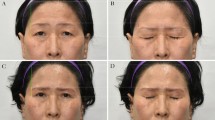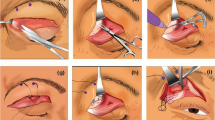Abstract
Background
There is an anecdotal belief among some surgeons performing Asian eyelid surgery that double eyelid surgery itself decreases eyebrow position. However, the exact amount of descent and the specific changes in the proportion of facial aesthetics are unknown.
Purpose
The goal of this study is to determine whether there indeed is a change in brow position after double eyelidplasty and to quantify the proportional differences associated with the change. The three-point double eyelids surgery method was used so that the change in the brow position is solely attributed to the surgery itself and not to the excision of redundant skin.
Methods
From January 2016 to December 2017, double eyelid surgery using the three-point technique was performed on 204 patients who did not require skin excision. Their pre- and postoperative photographs were standardized and analyzed. The ratio of the length between the upper edge of the eyebrow and the edge of the lower eyelid (A) and the length between the edge of the lower eyelid and the nasal base (B) as well as the subsequent change in the midfacial proportion was measured and analyzed.
Results
There was a statistically significant brow descent after double eyelidplasty. The average preoperative A/B was 0.71 and the average postoperative A/B was 0.67 (P < 0.001). Although the eyebrow distance did not change in 32.5% of patients, the remaining cohort showed average brow descent of 5.6%. And in this cohort that showed descent, linear regression showed that there was a correlation between the ratio of pre- and postoperative eyebrow distance
Conclusion
Double eyelid surgery can lower the eyebrow in patients with foldless eyelids. This is in accordance with clinical observation in Asian blepharoplasty. In addition, there are associated changes in the proportion of midfacial aesthetics after the surgery. Such knowledge can be helpful in preoperative consulting with patients as well as in predicting postoperative results.
Level of Evidence IV
This journal requires that authors assign a level of evidence to each article. For a full description of these Evidence-Based Medicine ratings, please refer to the Table of Contents or the online Instructions to Authors www.springer.com/00266.






Similar content being viewed by others
References
Yalcinkaya E, Cingi C, Soken H, Ulusoy S, Muluk NB (2016) Aesthetic analysis of the ideal eyebrow shape and position. Eur Arch Otorhinolaryngol 273(2):305–310
Frankel AS, Kamer FM (1997) The effect of blepharoplasty on eyebrow position. Arch Otolaryngol Head Neck Surg 123(4):393–396
Dar SA, Rubinstein TJ, Perry JD (2015) Eyebrow position following upper blepharoplasty. Orbit 34(6):327–330
Huijing MA, van der Palen J, van der Lei B (2014) The effect of upper eyelid blepharoplasty on eyebrow position. J Plast Reconstr Aesthet Surg 67(9):1242–1247
Nakra T, Modjtahedi S, Vrcek I, Mancini R, Saulny S, Goldberg RA (2016) The effect of upper eyelid blepharoplasty on eyelid and brow position. Orbit 35(6):324–327
Starck WJ, Griffin JE Jr, Epker BN (1996) Objective evaluation of the eyelids and eyebrows after blepharoplasty. J Oral Maxillofac Surg 54(3):297–302 (discussion 302–293)
Lee JM, Lee TE, Lee H, Park M, Baek S (2012) Change in brow position after upper blepharoplasty or levator advancement. J Craniofac Surg 23(2):434–436
Kim SS (2013) Effects in the upper face of far east Asians after Oriental blepharoplasty: a scientific perspective on why Oriental blepharoplasty is essential. Aesthetic Plast Surg 37(5):863–868
Kim D, Son D, Kim M, Harijan A, Yang S, Lee S (2015) Does upper blepharoplasty affect frontalis tonicity? J Plast Reconstr Aesthet Surg 68(5):638–644
Ma FY, Cheng MS (2010) Mini-incision double eyelidplasty. Aesthet Surg J 30(3):329–334
Rhee SC, Lee SH (2010) Attractive composite faces of different races. Aesthetic Plast Surg 34(6):800–801
Hassanpour SE, Khajouei Kermani H (2016) Brow ptosis after upper blepharoplasty: findings in 70 patients. World J Plast Surg 5(1):58–61
Park DD (2015) Aging Asian upper blepharoplasty and brow. Semin Plast Surg 29(3):188–200
Matros E, Garcia JA, Yaremchuk MJ (2009) Changes in eyebrow position and shape with aging. Plast Reconstr Surg 124(4):1296–1301
Park DH, Choi WS, Yoon SH, Song CH (2008) Anthropometry of Asian eyelids by age. Plast Reconstr Surg 121(4):1405–1413
Prado RB, Silva-Junior DE, Padovani CR, Schellini SA (2012) Assessment of eyebrow position before and after upper eyelid blepharoplasty. Orbit 31(4):222–226
Ji C, Li R, He W, Zhang J (2018) The aesthetic analyzing of midface ratio after folding aponeurosis of levator palpebrae superioris muscle in the ptosis correction. J Craniofac Surg 29(2):482–485
Kokubo K, Katori N, Hayashi K, Sugawara J, Fujii A, Maegawa J (2017) Evaluation of the eyebrow position after levator resection. J Plast Reconstr Aesthet Surg 70(1):85–90
Lee EI, Kim NH, Park RH, Park JB, Ahn TJ (2014) The Relationship between eyebrow elevation and height of the palpebral fissure: should postoperative brow descent be taken into consideration when determining the amount of blepharoptosis correction? Arch Aesthet Plast Surg 20(1):20
Wu XS, Jian XC, He ZJ, Gao X, Li Y, Zhong X (2010) Investigation of anthropometric measurements of anatomic structures of orbital soft tissue in 102 young han chinese adults. Ophthalmic Plast Reconstr Surg 26(5):339–343
Naif-de-Andrade NT, Hochman B, Naif-de-Andrade CZ, Ferreira LM (2012) Computerized photogrammetry used to calculate the brow position index. Aesthetic Plast Surg 36(5):1047–1051
Cole EA, Winn BJ, Putterman AM (2010) Measurement of eyebrow position from inferior corneal limbus to brow: a new technique. Ophthalmic Plast Reconstr Surg 26(6):443–447
Author information
Authors and Affiliations
Corresponding author
Ethics declarations
Conflict of interest
The authors declare that they have no conflict of interest.
Informed Consents
Informed consent was obtained from all individual participants included in the study.
Additional information
Publisher's Note
Springer Nature remains neutral with regard to jurisdictional claims in published maps and institutional affiliations.
Rights and permissions
About this article
Cite this article
Xu, L., Lee, E.I., Ma, T. et al. Aesthetic Analysis of Alteration of Eyebrow Position After Double Eyelidplasty. Aesth Plast Surg 44, 373–378 (2020). https://doi.org/10.1007/s00266-019-01590-4
Received:
Accepted:
Published:
Issue Date:
DOI: https://doi.org/10.1007/s00266-019-01590-4




